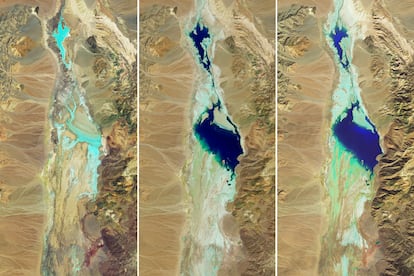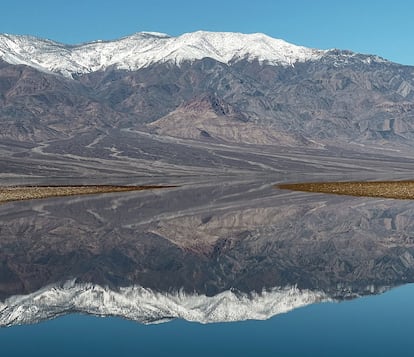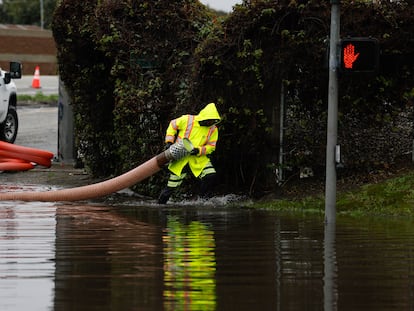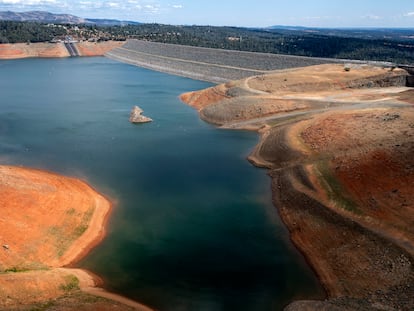Kayaks in the driest place in the United States? A lake resurfaces in Death Valley
The heavy rains recorded on the West Coast temporarily generated a body of water in the Badwater basin, located 282 feet below sea level


For a few days now, the National Park Service has been offering a “rare opportunity”: kayaking in Death Valley, considered the driest place in the United States. Lake Manly, located 310 miles (500 km) northeast of Los Angeles on the border between the States of California and Nevada, has resurfaced. The body of water has formed in the Badwater Basin, located 282 feet (86 m) below sea level, the lowest point in North America. The ephemeral lake had not been visible since 2005.
“You might think with no drain to the sea, that Death Valley would always have a lake. But this is an extremely rare event. Normally the amount of water flowing in is much less than the evaporation rate,” the park ranger Abby Wines said in a statement on Friday. The area has experienced some of the highest temperatures on record. In the summer of 1913 the thermometer supposedly logged 134º F (57º C). Last July, the mercury approached 130ºF (54.4º C).
Lake Manly is now about six miles long, three miles wide and one foot deep. Wines estimates that this is enough for kayaking for the “next two weeks or maybe a little longer.” The water has been carried by the Amargosa River, which flowed to the south of the basin thanks to the constant rains of the last year.
The lake began to form in August, when Tropical Storm Hilary brought record rainfall to the area. In just a couple of days, more rain fell than the annual average that Death Valley receives per year. Hilary not only left rainfall not seen in years, it also caused chaos. The large amount of water caused flooding and landslides that led the National Park Service to close the area for about two months. When the visitors returned, Lake Manly had already lost volume.

“Many of us believed that by October the lake would have disappeared. We are shocked that we are still seeing it six months later,” Wines said. According to the NASA observatory, the lake is still there thanks to the chain of atmospheric rivers that entered from the Pacific during February. This set of weather phenomena has caused nine deaths and multimillion-dollar damage. It has also left behind a voluminous amount of water, raising the arid region’s rainfall to five inches in the last six months.
Sign up for our weekly newsletter to get more English-language news coverage from EL PAÍS USA Edition
Tu suscripción se está usando en otro dispositivo
¿Quieres añadir otro usuario a tu suscripción?
Si continúas leyendo en este dispositivo, no se podrá leer en el otro.
FlechaTu suscripción se está usando en otro dispositivo y solo puedes acceder a EL PAÍS desde un dispositivo a la vez.
Si quieres compartir tu cuenta, cambia tu suscripción a la modalidad Premium, así podrás añadir otro usuario. Cada uno accederá con su propia cuenta de email, lo que os permitirá personalizar vuestra experiencia en EL PAÍS.
¿Tienes una suscripción de empresa? Accede aquí para contratar más cuentas.
En el caso de no saber quién está usando tu cuenta, te recomendamos cambiar tu contraseña aquí.
Si decides continuar compartiendo tu cuenta, este mensaje se mostrará en tu dispositivo y en el de la otra persona que está usando tu cuenta de forma indefinida, afectando a tu experiencia de lectura. Puedes consultar aquí los términos y condiciones de la suscripción digital.
More information
Archived In
Últimas noticias
Most viewed
- Sinaloa Cartel war is taking its toll on Los Chapitos
- Oona Chaplin: ‘I told James Cameron that I was living in a treehouse and starting a permaculture project with a friend’
- Reinhard Genzel, Nobel laureate in physics: ‘One-minute videos will never give you the truth’
- Why the price of coffee has skyrocketed: from Brazilian plantations to specialty coffee houses
- Silver prices are going crazy: This is what’s fueling the rally










































